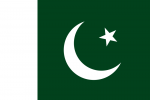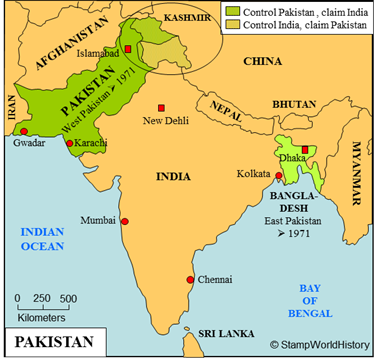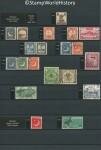پاكِستان

Pakistan
Quick reference
General issues: British Commonwealth, Dominion 1947-1956, Islamic republic 1956-Present
Country name on general issues: Pakistan
Special issues: Local issues 1947, Local issues 1961
Related issues: Las Bela 1897-1904, Bahawalpur 1947-1949
Currency: 1 Rupee = 16 Anna, 1 Anna = 12 Pie 1947-1961, 1 Rupee = 100 Paise 1961-Present
Population: West 35 298 000 + East 42 070 000 in 1947, Pakistan 62 425 000 in 1971, 182 100 000 in 2013
Political history Pakistan
Pakistan is located on the Indian subcontinent in southern Asia. In the 18th century the struggle between the colonial powers for the control over the Indian subcontinent is won by the British who form the colony of British India of which current Pakistan is a part. The British possessions are further extended in the 19th century until, at the end of the 19th and in the early 20th century, the borders of current Pakistan with the neighboring countries are defined. The British establish two forms of government in British India: direct colonial rule and indirect rule through the local sovereigns of the princely states. The call for independence of British India becomes stronger from the early 20th century. Independence is achieved in 1947. In view of the tension between the Hindu and Muslim population groups, upon independence two separate states are formed as dominions within the British Commonwealth: the predominantly Hindu India and the predominantly Muslim Pakistan. Pakistan, at the time, consists of two parts that, from 1955, are known as East and West Pakistan.
As part of the domestic policy, the princely states are, between 1947 and 1955, integrated in the centralized administration of Pakistan. To stress the Islamic identity of the country, Pakistan becomes an Islamic republic in 1956. The focus of the Pakistani government on West-Pakistan fuels the drive of independence of East Pakistan. After a liberation war, East Pakistan gains independence as the republic of Bangladesh in 1971.
In its foreign policy, Pakistan is confronted with a conflict with India over Kashmir, both states claiming the sovereignty over the territory. Already, in 1947, the conflict escalates into war. In 1965 India and Pakistan will confront each other in armed conflict again. The conflict over Kashmir has yet to be resolved. The Omani exclave of Gwadar is returned to Pakistan in 1958.
Pakistan has, since independence, been a politically unstable country, knowing both periods of military dictatorship and democratic rule. The tensions with India have led to the development of a large army with nuclear capabilities. Economically, Pakistan is – largely due to the political instability in the country – a low income, low growth country. Recently, the Pakistani government has been struggling to control rebellious groups, some having spilled over from neighboring Afghanistan.
Postal history Pakistan
Pakistan has, until 1947, used the stamps of British India, the first stamps in British India being issued in the Scinde, or Sind, district which is currently part of Pakistan. The princely states had the right to issue stamps for internal use – the feudatory states – or for use in all of British India – the convention states. Of the princely states located in current Pakistan, Las Bela issued stamps from 1897 until 1904 as a feudatory state. Bahawalpur gained the right to issue official stamps from 1945 and postage stamps from 1947, also as a feudatory state. The stamps of Bahawalpur were used until 1953. Please refer to the profile of India for more detailed information on and a map of the princely states in British India.
Pakistan issues stamps from 1947. The first issues are overprints on British Indian stamps applied both centrally and locally. Further overprints are issued both centrally and locally in 1961 when the currency is changed. Both these local issues are referred to, but not listed, in the catalogs.
Directly after independence in 1947, the Pakistani postal service takes over part of the British Indian services abroad: in Bahrain, Dubai, Kuwait and Oman. Pakistani stamps are used in Dubai and Oman. In 1948 the postal services in these countries are taken over by the British – Kuwait – and British Postal Agencies in Eastern Arabia – Bahrain, Dubai and Oman.
Album pages
← Previous page: OmanNext page: Palestine →







